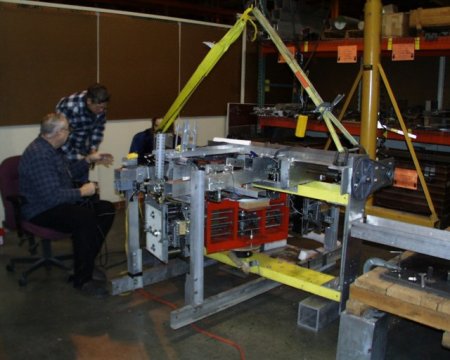-
Propulsion créée par la force différentielle de 2 masses rotatives
-
Propulsion créée par la force différentielle de 2 masses rotatives
The CIP (Centrifugal Inertial Propulsion) Engine - COE >200
Inventor: Robert L. CookThe inventors
Robert Cook was born in Presidio, a small town just north of the Mexican-American border in Texas, on March 1, 1934. Spanish was Cook's first language. He learned English when he was eight years old. He lived in a three room adobe house with his parents, aunts and uncle, three brothers, and one sister. As a young man in his teens he began learning mechanics through the hands-on experience of making repairs of all types to motorcars. When he was barely seventeen, he learned the printing trade where he gained mechanical experience that would later prove invaluable to his creation of the Cook Inertial Propulsion engine. Cook has now been working on his CIP project for thirty-four years. He is co-author of two books: "The Death of Rocketry" with Joel Dickinson, and "The Man Who Changed the Future" by Lynden Herbert (Professor of Oxford and Cambridge and grandson of Sir George Herbert-"The Fifth Earl of Carnarvon"-who is famous for funding the expedition that discovered King Tut's tomb). Cook has been married since 1978 to his wife Scherl. They have four sons: Robert, Victor,Benjamin, and Joseph. In his free time he likes to fly. He earned a pilot's license and has logged about 2000 hours flying various airplanes. He enjoys both listening to and playing music. He can play the guitar and various brass instruments. Cook hopes to develop two more inventions— a water purification device and a non-polluting energy production system. He has finally completed writing his book, God's Demonstrations, the book that inspired him to invent the CIP engine. He was not originally out to topple Isaac Newton nor the scientific community when he invented the device. At first he was not even aware that his device violated any of Newton's principles.
Description of the invention

The Cook Inertial Propulsion Engine
Robert Cook besides his machine in December 1999The device utilizes centrifugal force and exchangeable weights timed in such a way that they never go around the back half of the unit. The weights can be put on and taken off of the unit without creating any measurable shock of any kind.
Tests conducted have shown that the less friction there is, the better it works. All units that were capable of producing a fairly constant force moved smoothly on a flat surface, unlike other so-called reactionless devices that move in a jerky fashion. Most of those are "propelled" by Coriolis force whether the inventors of those devices know it or not. This device certainly does not utilize that force.
One of the models even propelled upward on a slight incline of low friction. In fact, when this particular model was run without the exchangeable weights, it moved back downhill proving that friction could have only hindered the device.
The CIP engine converts centrifugal force (angular momentum) into a linear or translational force. In other words, it converts J = I ω to P = M V
When John Wallis wrote the laws of the conservation of angular momentum (which Sir Isaac Newton plagiarized) he plainly stated that angular momentum could not be converted to a translational force because it had none to give!
The way he reasoned was: because the constants I and ω had to remain constant (or the same) for 360°of spin, the net result had to be forces in equilibrium which could only create bounded motion. This would tie into Newton's 3rd law of action and reaction.
Link to inventor's website

